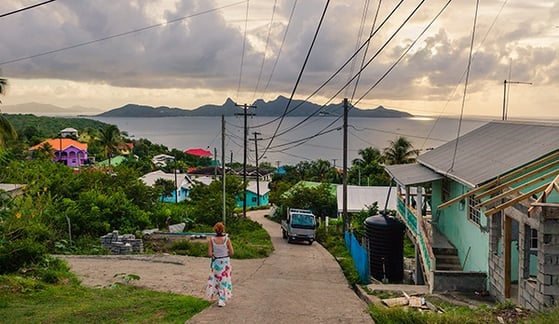Our hearts go out to all those in areas affected by the recent hurricanes in the Atlantic and Gulf of Mexico. AES has been operating in Puerto Rico and the Dominican Republic for two decades and these two islands are home to hundreds of our colleagues and their families. In Puerto Rico, much of the island’s infrastructure was devastated and our colleagues have been working to help by sending water, food, and other supplies to nearby communities, providing 1,500 gallons of diesel to the Puerto Rico Sewage Authority supporting the water plant servicing Guayama, and clearing debris from roadways and electrical lines. Both AES generation plants on the island are available, including a 24 MW solar facility; however, many of Puerto Rico’s high-voltage transmission and distribution lines that deliver power were destroyed during the hurricanes. AES teams are working closely with the grid operator in order to restart delivering energy to the island as soon as possible.
Current research shows extreme weather events like Hurricanes Harvey, Irma and Maria are becoming more damaging – forcing communities, governments and the electric power sector to take a hard look at grid planning and look for ways to make the grid more resilient. The Dominican Republic offered a surprising example during September’s storms – using battery-based energy storage to keep its grid operating, despite damage to power lines and 40% of its generating assets being forced offline.
As everyone from industry experts and major news outlets to individual users debate what can be done to reduce the impact of these events and how we can better prepare for the next one, it’s important to understand what resilience means for electricity – and how energy storage is demonstrating it can help provide it.

The Value of Resilience on the Electric Grid
Resilience is the electric grid’s ability to bounce back after a disruptive event, such as a severe storm, fuel disruption, or a cyberattack. The greater the grid’s level of resilience, the less short-term and long-term impact these disruptions will have – on the grid itself, on utility bills, on businesses’ ability to keep operating, people’s ability to live and communities’ ability to function.
While some companies are advocating to reduce the role of the electric grid in favor of building out individual household solar and storage systems, we believe that the best and most cost-effective way to achieve resilience for entire communities is through the development of unbreakable grids, ones that are impervious to disruptions in the first place and “self-healing.”
A more resilient and unbreakable grid can take many forms. Burying power lines makes them less prone to damage from high winds. Adding more distributed generation and renewable energy closer to major energy users – denser communities, factories or office parks, for example – reduces fuel use and risk of major outages if a central asset goes down. Enabling the use of microgrids and machine learning improves how energy resources are dispatched and boosts the efficiency of the broader grid. And as we’ve found in six countries and counting, adding energy storage is another key way for grid operators to boost resilience.
How Energy Storage Can Help
Energy storage provides a buffer between supply and demand that enables electric systems to rebalance during and after a disturbance. Many of the disturbances that occur on the grid are short in duration, from a single generator tripping offline or transmission line getting pulled down by storm conditions, to smaller swings in output when clouds or large gusts of wind move across a region. Energy storage can regulate mismatches between energy supply and demand on the grid on a second-by-second basis, giving operators enough time to rebalance the system. Our new case study shows real-time data from energy storage systems providing frequency response under both normal and storm conditions.
During longer outages, long-duration energy storage (4 hours or longer) can be paired with renewable and/or thermal generation to meet key power needs across more of the day. Storage can be integrated as part of a microgrid that services critical industries such as hospitals or can be connected directly to the grid to provide reliability and flexibility. Storage can also provide “black start” services – providing the external power needed to restart electric power stations or portions of the grid after a partial or complete shutdown.
Energy Storage in Action: Grid Resilience During September Storm
The resilience of one grid in particular, in the Dominican Republic, was put to the test this year as Hurricane Irma charted a path toward it. In anticipation of Irma’s arrival, grid operators ordered our colleagues at AES Dominicana to keep online and operational during the storm its two 10 MW, 30-minute duration Advancion energy storage arrays at its Andres and Los Mina Dominican Power Partner facilities. The two arrays, completed earlier this year, were operated from one of Dominicana’s thermal plant control rooms and remotely monitored by the AES Energy Storage team to ensure proper operation and to provide the local operators with remote assistance if required.

As the storm struck, power lines were damaged, distribution lines were disconnected in high-risk areas, and almost 40 percent of the generation assets on the island were forced offline, putting additional stress on the system. To maintain grid frequency during 10 hours of volatile fluctuations during the storm, both energy storage arrays performed more than double the amount of work as normal, which helped keep the Dominican grid operating as the storm passed. The additional power output delivered by the energy storage arrays was equivalent to instantaneously adding a thermal power plant of approximately 30 MW to the grid.
Resilience Aids Faster Recovery for Communities
Access for everyone to clean reliable power is a necessity during and after severe weather events -- helping hospitals and emergency services to provide life-saving services, powering refrigeration and cooling systems during hot summer weather, enabling telecommunications and data centers to remain online, and keeping communities connected to coordinate recovery efforts.
To ensure that access, we need to elevate and strengthen our electric grids by including energy storage in how we plan and build (or rebuild) them. The resilience it offers in the face of extreme weather will empower people and communities to focus on what matters most – rebuilding and recovery.

















